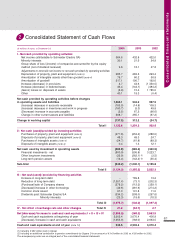APC 2004 Annual Report Download - page 69
Download and view the complete annual report
Please find page 69 of the 2004 APC annual report below. You can navigate through the pages in the report by either clicking on the pages listed below, or by using the keyword search tool below to find specific information within the annual report.
67
1.14 - Cash and cash equivalents
Cash and cash equivalents as presented in the bal-
ance sheets consist of cash, bank accounts, treasury
shares to be used to cover stock options, short-term
deposits and other liquid marketable securities.
Substantially all marketable securities represent
short-term instruments such as commercial paper,
mutual funds and equivalents. They are valued at the
lower of cost or market. In the case of bonds and other
debt instruments, cost includes accrued interest.
1.15 - Treasury stock
Schneider Electric shares held by the parent compa-
ny or by companies fully consolidated are either:
Recorded as cash and cash equivalents in the
accompanying consolidated balance sheets, where
such treasury stock is explicitly assigned to stock
option plans for the benefit of employees; or
Deducted from consolidated shareholders' equity in
all other situations.
The accounting treatment of the gain or losses result-
ing from the sale of treasury stock depends on the
intended purpose of holding the stock. Gains or loss-
es on sales of securities classified as cash and cash
equivalents are recorded in the accompanying con-
solidated statement of income. Other gains and loss-
es are deducted from consolidated shareholders'
equity, net of tax.
1.16 - Pensions and other
post-retirement benefit obligations
Depending on local practices and laws, the Group's
subsidiaries participate in pension, insurance and
statutory retirement bonus plans. Benefits paid under
these plans depend on such factors as seniority, com-
pensation levels and payments into mandatory retire-
ment programs. The method used to value retirement
benefits takes into account future compensation levels.
Two methods are used to calculate the Group's liabil-
ity for statutory retirement benefits:
Accruals - the accrual is calculated for all eligible
employees based on the determination of the present
value of the future liability using a rate reviewed each
year and based on market conditions.
External funding under an insured plan - in this spe-
cific case, an amount is reserved to cover any deficit
between the fair value of plan assets and the present
value of the estimated future liability.
Changes resulting from periodic changes in actuarial
assumptions regarding general financial and busi-
ness conditions or demographics (i.e., changes in the
discount rate, annual salary increases, return on
assets, years of service, etc.) are deferred and recog-
nized over the remaining service life of the employees
concerned, if they exceed 10 % of the greater of the
projected benefit obligations or market-related value
of plan assets.
The Group also provides supplemental retirement
benefits to a limited number of active and retired
senior executives. These defined benefit obligations
are accrued for based on the contractual terms of the
agreements, which provide guaranteed minimum pay-
ment terms beyond the general retirement benefit
scheme.
Accruals are booked to cover the cost of providing
healthcare benefits for certain retired employees. The
Group also records an obligation for long service
awards in its French subsidiaries.
1.17 - Provisions for contingencies
The Group recognizes losses and accrues for liabili-
ties when available information indicates that such
loss or liability is probable and reasonably estimable.
In the event that the loss or liability is neither probable
nor reasonably estimable but remains possible, the
Group discloses this contingency in the notes to its
consolidated financial statements.
1.18 - Fair value of financial
instruments/derivatives
The Group's policy is to use derivative financial instru-
ments exclusively to manage and cover changes in
exchange rates, interest rates or prices of raw materi-
als. It therefore periodically enters into contracts such
as swaps, options and futures, depending upon the
nature of its exposure. However, the Group does not
enter into derivative financial instruments for specula-
tive purposes.
The Group periodically enters into foreign currency
contracts to hedge foreign currency transactions.
Some of these contracts are designated as hedges of
operating receivables and payables carried in the bal-
ance sheets of Group companies. Gains or losses on
transaction hedges are recognized in income and off-
set the gains or losses on the related transaction.
At year-end, foreign currency contracts are marked to
market and unrealized gains or losses are reflected in
income. These unrealized gains or losses offset for-
eign currency differences from translating foreign cur-
rency payables and receivables into the reporting cur-
rency at the year-end rates.
The Group may also hedge recurring future transac-
tions or planned acquisitions or disposals of invest-
ments. The Group does not have any policy of hedg-
ing the balance sheets of foreign subsidiaries.
The market value of these hedging instruments is pro-
vided in Note 20.5.
Consolidated financial statements
























